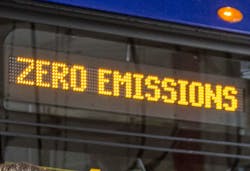CALSTART report: U.S. sees 27 percent increase in zero-emission buses, Canada doubles its number of ZEBs
The North American transit industry’s adoption of zero-emission buses (ZEB) has been steady over the past year, according to the latest annual report “Zeroing in on ZEBs” from CALSTART.
In the U.S., 725 full-size ZEBs were added, which is a 27 percent increase since 2020. In Canada, the number of vehicles doubled with the addition of 307 new buses.
CALSTART believes this momentum for ZEBs is expected to increase with the wide availability of funding from both the U.S. and Canadian governments.
The Bipartisan Infrastructure Deal that was signed into law in November 2021 is set to provide $5.25 billion through the Federal Transit Administration’s Low-No Program. Canada’s government has committed to purchasing 5,000 zero-emission buses over a five-year period and is providing C$2.75 billion (US$2.17 billion) over five years toward helping transportation providers transition to electric power. This is in addition to the C$1.5 billion (US$1.18 billion) the Canada Infrastructure Bank committed to zero-emission buses and associated infrastructure as part of its three-year Growth Plan.
Zeroing in on ZEBs: United States
As of September 2021, the U.S. had 3,533 full-size ZEBs. California leads in the number of deployments with New York and Washington state following. Of note is that New York increased its orders of full-size ZEBs from 77 in 2020 to 195 in 2021.
This year’s report includes a breakdown of full-size and small buses. The report found most ZEB fleets are small with 10 or fewer vehicles and the number of small ZEB deployments increased by 51 percent compared to 2020. Of the 67 transit agencies that have small ZEBs, 22 only have one bus and 58 agencies have four or fewer buses.
“Early adopters such as large transit agencies in California, New York, Florida, Kentucky and Oregon continue to lead, but still are not at scale,” said Jared Schnader, director of Bus Programs at CALSTART. “Smaller transit agencies and regions that are not familiar with zero-emission technologies need additional resources and effort to begin their transition.”
The report also notes airports have adopted 131 full-size and 119 small ZEBs. This increase represents 35 percent and 19 percent growth from 2020, respectively.
Fuel cell electric buses (FCEBs) increased by 87 vehicles for a total of 169. California and Massachusetts added to their FCEB fleets and Texas and Washington transit agencies adopting FCEBs for the first time. CALSTART notes long routes and operational needs can drive this choice in addition to infrastructure, cost and owner/operator preference.
Zeroing in on ZEBs: Canada
As of September 2021, Canada had 606 full-size ZEBs in seven of its 10 provinces. Ontario currently has 423 ZEBs, 413 of these are battery-electric and 10 of FCEBs.
"Ontario is an early adopter, and its transit agencies are primed to scale operations with the additional investment pledged by the government," said Schnader. "With the stated goal of 5,000 ZEBs by 2025 nationally, we expect to see significant growth across the provinces."
The report found battery-electric buses still vastly outnumber FCEBs in Canada, with only 10 FCEBs and those being only in Ontario.
The report can be viewed on CALSTART's website.

Mischa Wanek-Libman | Group Editorial Director
Mischa Wanek-Libman is director of communications with Transdev North America. She has more than 20 years of experience working in the transportation industry covering construction projects, engineering challenges, transit and rail operations and best practices.
Wanek-Libman has held top editorial positions at freight rail and public transportation business-to-business publications including as editor-in-chief and editorial director of Mass Transit from 2018-2024. She has been recognized for editorial excellence through her individual work, as well as for collaborative content.
She is an active member of the American Public Transportation Association's Marketing and Communications Committee and served 14 years as a Board Observer on the National Railroad Construction and Maintenance Association (NRC) Board of Directors.
She is a graduate of Drake University in Des Moines, Iowa, where she earned a Bachelor of Arts degree in Journalism and Mass Communication.



